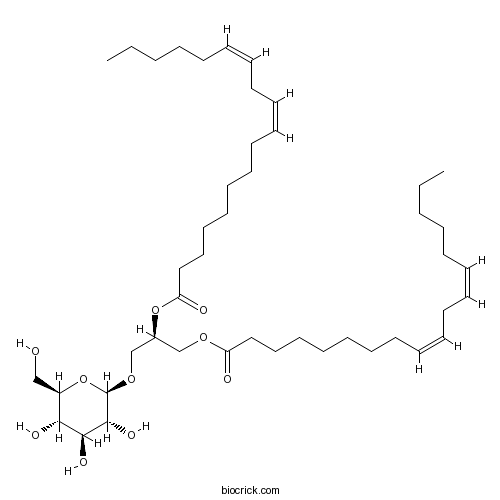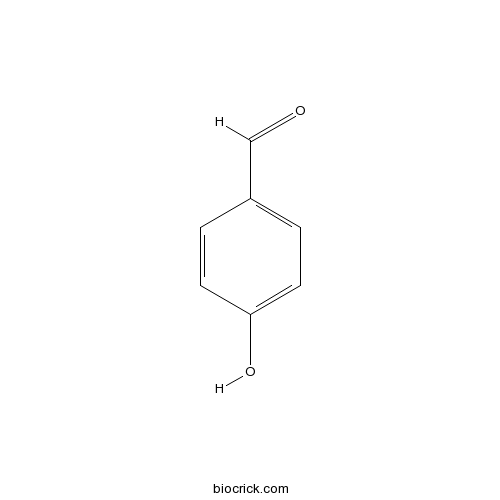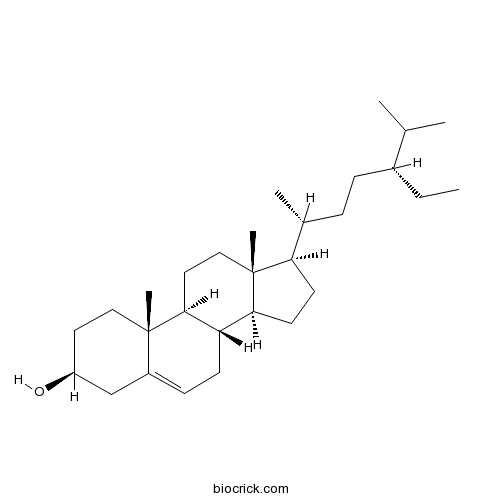Sparganium stoloniferum
Sparganium stoloniferum
1. The products in our compound library are selected from thousands of unique natural products; 2. It has the characteristics of diverse structure, diverse sources and wide coverage of activities; 3. Provide information on the activity of products from major journals, patents and research reports around the world, providing theoretical direction and research basis for further research and screening; 4. Free combination according to the type, source, target and disease of natural product; 5. The compound powder is placed in a covered tube and then discharged into a 10 x 10 cryostat; 6. Transport in ice pack or dry ice pack. Please store it at -20 °C as soon as possible after receiving the product, and use it as soon as possible after opening.
Natural products/compounds from Sparganium stoloniferum
- Cat.No. Product Name CAS Number COA
-
BCN6768
1,2-O-Dilinoleoyl-3-O-beta-D-galactopyranosylracglycerol111187-15-6
Instructions

-
BCN5816
4-Hydroxybenzaldehyde123-08-0
Instructions

-
BCN1664
Erythritol149-32-6
Instructions

-
BCN1015
Beta-Sitosterol83-46-5
Instructions

Two new sucrose esters from the rhizome of Sparganium stoloniferum Buch.-Ham.[Pubmed: 29149799]
Two new sucrose esters, β-D-(1-O-acetyl-3,6-O-trans-diferuloyl)fructofuranosyl-α-D-2'-O-acetylglucopyranoside (1) and β-D-(1-O-acetyl-3-O-cis-feruloyl-6-O-trans-feruloyl)fructofuranosyl-α-D-2',4',6'-O-triacetylglucopyranoside (2), together with four known sucrose esters (3-6) have been isolated from the rhizome of Sparganium stoloniferum Buch.-Ham. Their structures were elucidated by physical and chemical evidence and spectral analysis.
[Oligopeptides in plant medicines cited in Chinese Pharmacopoeia].[Pubmed: 28920330]
In total, 23 plant plant medicined containing oligopeptides were cited in Chinese Pharmacopoeia (1 part) of 2015 version including Rubia cordifolia, Linum usitatissimum, Aster tataricus, Psammosilene tunicoides, Pseudostellaria heterophylla, Stellaria dichotoma, Vaccaria segetalis, Dianthus superbus, Celosia argentea, Lycii Cortex, Citrus medica, C. aurantium, Panax ginseng, Parmx notoginseng, Schisandra chinensis, Sparganium stoloniferum, Euryale ferox, Ophiopogon japonicas, Pinellia ternate, Achyranthes bidentata, Physalis alkekengi, Polygonatum odoratum, and Leonuri Fructus. There were 187 oligopeptides in plant medicines above as reported. Oligopeptides consisted mainly of linear peptides and cyclic peptides. The linear peptides included dipeptides, tripeptides and pentapeptides, and cyclic peptides included cyclic, bicyclic and tricyclic peptides. The number of residues of single cyclic peptides ranged from two to twelve. Bicyclic peptides were isolated mainly from R. cordifolia and C. argentea. Modern pharmacological study showed that oligopeptides had many pharmacological effects, including antitumor, anticoagulant, antibacterial, immune suppression and so on.
New isocoumarin and stilbenoid derivatives from the tubers of Sparganium stoloniferum (Buch.-Ham.).[Pubmed: 27500418]
A new isocoumarin derivative 8,5'-dihydroxy-6'-methoxy-4-phenyl-5,2'-oxidoisocoumarin (1) and a new stilbenoid derivative methyl 5-hydroxy-2-(2-hydroxyphenyl)benzofuran-4-carboxylate (2) together with nine known compounds (3-11) were isolated from the tubers of Sparganium stoloniferum Buch.-Ham.. Another stilbenoid derivative (3) and a xanthone (4) were identified as new natural products and compounds 5-10 were obtained for the first time from the genus Sparganium. All their structures were elucidated by comprehensive spectroscopic analysis and comparison with available literature information.
[Interception Effect of Vegetated Drainage Ditch on Nitrogen and Phosphorus from Drainage Ditches].[Pubmed: 27011988]
In order to effectively intercept and remove nitrogen (N) and phosphorus (P) from agricultural water, Canna glauca, Sparganium stoloniferum, Juncus effusus, Hydrocotyle vulgaris, and Myriophyllum elatinoides were planted in an agricultural drainage ditch. The temporal and spatial variations of the dissolved N and P concentrations were monitored during the whole experimental period. In addition, the contents of N and P in sediments and plants were compared among different plant plots. The results showed the effluent TN and TP concentrations in the vegetated drainage ditch were lower than the surface water environmental quality standards for class IV and class II . The average removal rates of TN and TP in water were 64.3% and 69.7%, respectively. The average sediment interceptions in 2010 and 2011 reached 40,400 kg, containing 52.4 kg of N and 21.4 kg of P. The amounts of sediment N and P in five plant plots exhibited the descending order: Canna glauca > Hydrocotyle vulgaris > Sparganium stoloniferum > Myriophyllum elatinoides > Juncus effuses. The accumulated N and P amounts assimilated by five kinds of aquatic plants reached 7.9 kg · a⁻¹ and 1.4 kg · a⁻¹, respectively. Compared with other plants, Canna glauca and Myriophyllu elatinoides had the highest ratios of above-ground and below-ground tissues, and the strongest absorption capacity of N and P was also observed in these two plants. Therefore, the vegetated drainage ditch has good interception effect on N and P pollutants. Furthermore, Canna glauca and Myriophyllum elatinoides can be considered as the optimal plants for N and P uptake.
Two new phenolic compounds from the tuber of Sparganium stoloniferum.[Pubmed: 26981878]
Two new phenolic compounds, 2-(2-hydroxyphenyl)-4-methoxycarbonyl-5-hydroxybenzofuran (1) and 1-methoxycarbonyl-2, 3-dihydroxydibenzo[b, f]oxepine (2), were isolated from the tuber of Sparganium stoloniferum. The structures of both new compounds were determined on basis of spectroscopic means including HR-ESI-MS, 1D and 2D NMR experiments.
Sparstolonin B attenuates early liver inflammation in experimental NASH by modulating TLR4 trafficking in lipid rafts via NADPH oxidase activation.[Pubmed: 26718771]
Although significant research data exist on the pathophysiology of nonalcoholic steatohepatitis (NASH), finding an efficient treatment regimen for it remains elusive. The present study used sparstolonin B (SsnB), a novel TLR4 antagonist derived from the Chinese herb Sparganium stoloniferum, as a possible drug to mitigate early inflammation in NASH. This study used an early steatohepatitic injury model in high-fat-fed mice with CYP2E1-mediated oxidative stress as a second hit. SsnB was administered for 1 wk along with bromodichloromethane (BDCM), an inducer of CYP2E1-mediated oxidative stress. Results showed that SsnB administration attenuated inflammatory morphology and decreased elevation of the liver enzyme alanine aminotransferase (ALT). Mice administered SsnB also showed decreased mRNA expression of proinflammatory cytokines TNF-α, IFN-γ, IL-1β, and IL-23, while protein levels of both TNF-α and IL-1β were significantly decreased. SsnB significantly decreased Kupffer cell activation as evidenced by reduction in CD68 and monocyte chemoattractant protein-1 (MCP1) mRNA and protein levels with concomitant inhibition of macrophage infiltration in the injured liver. Mechanistically, SsnB decreased TLR4 trafficking to the lipid rafts, a phenomenon described by the colocalization of TLR4 and lipid raft marker flotillin in tissues and immortalized Kupffer cells. Since we have shown previously that NADPH oxidase drives TLR4 trafficking in NASH, we studied the role of SsnB in modulating this pathway. SsnB prevented NADPH oxidase activation in vivo and in vitro as indicated by decreased peroxynitrite formation. In summary, the present study reports a novel use of the TLR4 antagonist SsnB in mitigating inflammation in NASH and in parallel shows a unique molecular mechanism of decreasing nitrative stress.
Sparstolonin B inhibits lipopolysaccharide-induced inflammation in 3T3-L1 adipocytes.[Pubmed: 26522926]
Sparstolonin B (SsnB), an isocoumarin compound isolated from the tubers of both Sparganium stoloniferum and Scirpus yagara, has been reported to have anti-inflammatory effects. However, whether SsnB has anti-inflammatory effects on LPS-stimulated 3T3-L1 adipocytes remains unclear. In this study, we investigated the effects of SsnB on adipocyte inflammation in 3T3-L1 adipocytes and anti-obesity properties in high fat diet (HFD)-induced obese rats. 3T3-L1 adipocytes were pretreated with SsnB 1h before LPS treatment. The expression of MCP-1, IL-6, TNF-α, and IL-10 were measured by qRT-PCR and ELISA. The expression of PPAR-γ, TLR4 and NF-κB were detected by western blotting. SsnB was administered to HFD-induced obese rats to confirm its effects in vivo. Our results showed that SsnB dose-dependently inhibited LPS-induced MCP-1, IL-6, and TNF-α production. SsnB was found to inhibit LPS-induced TLR4 expression and NF-κB activition. Furthermore, SsnB was found to activate PPAR-γ and the inhibitory effects of SsnB on MCP-1, IL-6, and TNF-α production can be reversed by PPAR-γ antagonist GW9662. In vivo, SsnB was found to reduce the body weight of rats fed with HFD. SsnB also inhibited the levels of serum triglyceride (TG) and cholesterol (TC) induced by HFD. In conclusion, the results suggested that SsnB could reduce HFD-induced obesity in rats and inhibited LPS-induced cytokines production in 3T3-L1 adipocytes by activating PPAR-γ.
Antioxidant activities in vitro and in vivo of water-soluble polysaccharide isolated from Sparganium stoloniferum Buch.-Ham.[Pubmed: 25553692]
In this study, the crude polysaccharides from Sparganium stoloniferum Buch.-Ham were prepared using hot-water extraction and further deproteinzated by Sevage method. The purified fraction of crude polysaccharide was obtained using a DEAE-52 cellulose chromatography and named with WSSP. Then, the antioxidant capacities of WSSP were assessed in vitro and in vivo. The results in vitro indicated that the WSSP possessed notably free radical scavenging capacity. And the antioxidant abilities were dose-dependent and increased with increasing dose of sample. The findings in vivo showed the gavage administration of WSSP can increase SOD and TAOC activities, and decrease MDA levels in tissue and serum of mice. Therefore, the WSSP may serve as a potential antioxidant.
Sparstolonin B, a novel plant derived compound, arrests cell cycle and induces apoptosis in N-myc amplified and N-myc nonamplified neuroblastoma cells.[Pubmed: 24788776]
Neuroblastoma is one of the most common solid tumors and accounts for ∼ 15% of all the cancer related deaths in the children. Despite the standard therapy for advanced disease including chemotherapy, surgery, and radiation, the mortality rate remains high for these patients. Hence, novel therapeutic agents are desperately needed. Here we examined the anticancer activity of a novel plant-derived compound, sparstolonin B (SsnB; 8,5'-dihydroxy-4-phenyl-5,2'-oxidoisocoumarin) using neuroblastoma cell lines of different genetics. SsnB was recently isolated from an aquatic Chinese herb, Sparganium stoloniferum, and tubers of this herb have been used in traditional Chinese medicine for the treatment of several inflammatory diseases and cancers. Our cell viability and morphological analysis indicated that SsnB at 10 µM concentration significantly inhibited the growth of both N-myc amplified (SK-N-BE(2), NGP, and IMR-32 cells) and N-myc nonamplified (SH-SY5Y and SKNF-1 cells) neuroblastoma cells. The flow cytometric analyses suggested that SsnB arrests the cell cycle progression at G2-M phase in all neuroblastoma cell lines tested. Exposure of SsnB inhibited the compact spheroid formation and reduced the tumorigenicity of SH-SY5Y cells and SK-N-BE(2) cells in in vitro 3-D cell culture assays (anchorage-independent colony formation assay and hanging drop assay). SsnB lowers the cellular level of glutathione (GSH), increases generation of reactive oxygen species and activates the cleavage of caspase-3 whereas co-incubation of a GSH precursor, N-acetylcysteine, along with SsnB attenuates the inhibitory effects of SsnB and increases the neuroblastoma cell viability. Our results for the first time demonstrate that SsnB possesses anticancer activity indicating that SsnB-induced reactive oxygen species generation promotes apoptotic cell death in neuroblastoma cells of different genetic background. Thus these data suggest that SsnB can be a promising drug candidate in neuroblastoma therapy.


